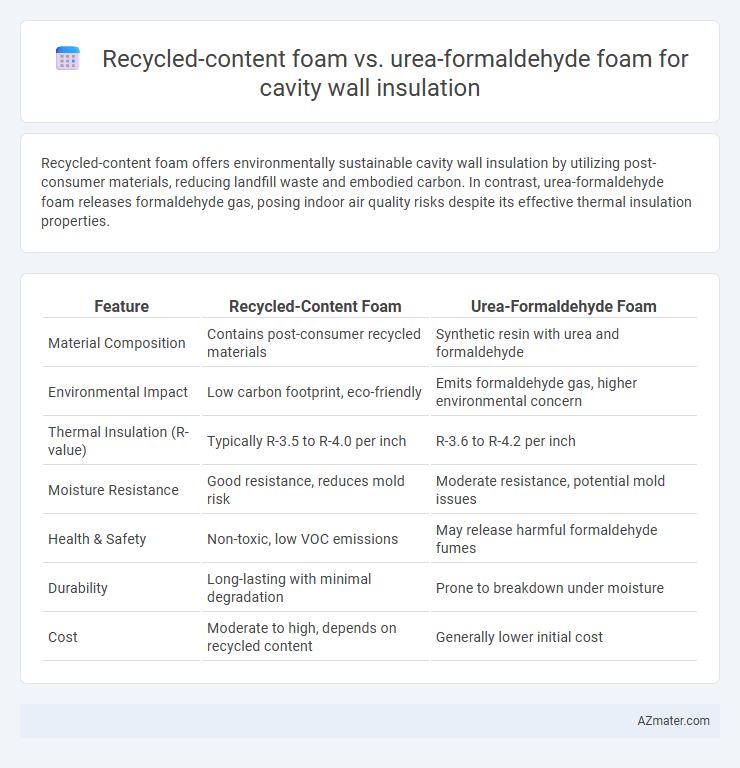Recycled-content foam offers environmentally sustainable cavity wall insulation by utilizing post-consumer materials, reducing landfill waste and embodied carbon. In contrast, urea-formaldehyde foam releases formaldehyde gas, posing indoor air quality risks despite its effective thermal insulation properties.
Table of Comparison
| Feature | Recycled-Content Foam | Urea-Formaldehyde Foam |
|---|---|---|
| Material Composition | Contains post-consumer recycled materials | Synthetic resin with urea and formaldehyde |
| Environmental Impact | Low carbon footprint, eco-friendly | Emits formaldehyde gas, higher environmental concern |
| Thermal Insulation (R-value) | Typically R-3.5 to R-4.0 per inch | R-3.6 to R-4.2 per inch |
| Moisture Resistance | Good resistance, reduces mold risk | Moderate resistance, potential mold issues |
| Health & Safety | Non-toxic, low VOC emissions | May release harmful formaldehyde fumes |
| Durability | Long-lasting with minimal degradation | Prone to breakdown under moisture |
| Cost | Moderate to high, depends on recycled content | Generally lower initial cost |
Introduction to Cavity Wall Insulation
Cavity wall insulation enhances building energy efficiency by filling the gap between inner and outer walls to reduce heat loss. Recycled-content foam uses environmentally friendly materials with lower embodied energy, while urea-formaldehyde foam offers effective thermal insulation but raises concerns due to formaldehyde emissions. Selecting the appropriate foam depends on balancing sustainability goals, insulation performance, and indoor air quality considerations.
Understanding Recycled-Content Foam
Recycled-content foam for cavity wall insulation incorporates post-consumer or industrial waste materials, reducing environmental impact by diverting waste from landfills. This foam type typically offers effective thermal performance and moisture resistance, comparable to conventional insulation, while minimizing the carbon footprint associated with raw material extraction. Understanding the balance between sustainability and insulating efficiency is crucial when selecting recycled-content foam over traditional urea-formaldehyde foam, which contains formaldehyde that may emit VOCs and pose health risks.
Overview of Urea-Formaldehyde Foam
Urea-formaldehyde foam (UFF) is a liquid-based insulation material injected into cavity walls, expanding to fill gaps and reduce heat loss effectively. It features a closed-cell structure that provides good thermal resistance but may release formaldehyde gas over time, posing indoor air quality concerns. Despite its initial low cost and ease of application, UFF has largely been replaced by safer alternatives like recycled-content foam due to environmental and health considerations.
Environmental Impact Comparison
Recycled-content foam for cavity wall insulation significantly reduces environmental impact by lowering landfill waste and decreasing reliance on virgin petroleum-based materials, promoting sustainability through material reuse. Urea-formaldehyde foam releases formaldehyde, a volatile organic compound linked to indoor air quality issues and potential health risks, contributing to environmental pollution during both manufacturing and installation processes. Lifecycle assessments show recycled-content foam has a smaller carbon footprint and fewer hazardous emissions, making it a more eco-friendly choice for cavity wall insulation.
Health and Safety Considerations
Recycled-content foam for cavity wall insulation offers lower levels of volatile organic compounds (VOCs), reducing indoor air pollution and potential respiratory issues compared to Urea-formaldehyde foam, which is known to emit formaldehyde gas linked to health risks such as eye, nose, and throat irritation. Proper installation and adequate ventilation are critical when using Urea-formaldehyde foam to minimize off-gassing and ensure occupant safety. Health and safety regulations increasingly favor recycled-content foam due to its reduced chemical hazards and environmental benefits while maintaining effective thermal performance.
Thermal Performance and Efficiency
Recycled-content foam offers enhanced thermal performance with lower thermal conductivity, ensuring better energy efficiency in cavity wall insulation compared to urea-formaldehyde foam. Urea-formaldehyde foam tends to have higher vapor permeability, which can reduce its insulating effectiveness over time. Utilizing recycled-content foam improves long-term thermal stability and contributes to sustainable building practices.
Installation Process and Practicality
Recycled-content foam for cavity wall insulation typically offers easier installation due to its lightweight nature and compatibility with various cavity sizes, reducing labor time and waste on-site. Urea-formaldehyde foam requires precise handling and mixing during application, making the installation process more complex and demanding specialized equipment to avoid health hazards from formaldehyde emissions. In terms of practicality, recycled-content foam provides environmental benefits and often better moisture resistance, whereas urea-formaldehyde foam can be cost-effective but poses concerns about indoor air quality and long-term durability.
Cost Analysis: Upfront and Long-Term
Recycled-content foam typically offers lower upfront costs due to the use of sustainable raw materials and less intensive manufacturing processes compared to urea-formaldehyde foam, which may incur higher initial expenses due to specialized chemical components. In the long term, recycled-content foam provides cost savings through enhanced thermal performance and reduced environmental impact fees, while urea-formaldehyde foam may lead to increased maintenance costs linked to potential off-gassing and degradation. Evaluating lifecycle expenses shows recycled-content foam as a more economically viable solution for cavity wall insulation with sustainable benefits.
Durability and Longevity
Recycled-content foam for cavity wall insulation offers enhanced durability with resistance to moisture infiltration and structural degradation, promoting long-term thermal performance. Urea-formaldehyde foam, while initially effective, tends to deteriorate over time due to chemical breakdown and off-gassing, potentially reducing insulation lifespan. Selecting recycled-content foam supports sustained cavity wall integrity and energy efficiency over multiple decades.
Choosing the Right Insulation for Your Needs
Choosing the right cavity wall insulation involves comparing recycled-content foam and urea-formaldehyde foam based on environmental impact, thermal performance, and health considerations. Recycled-content foam offers sustainable benefits with reduced embodied carbon and lower VOC emissions, while urea-formaldehyde foam provides excellent insulation but may emit formaldehyde, a potential indoor air pollutant. Evaluating factors such as energy efficiency, material safety, and long-term durability ensures the optimal insulation choice tailored to your specific building requirements.

Infographic: Recycled-content foam vs Urea-formaldehyde foam for Cavity wall insulation
 azmater.com
azmater.com